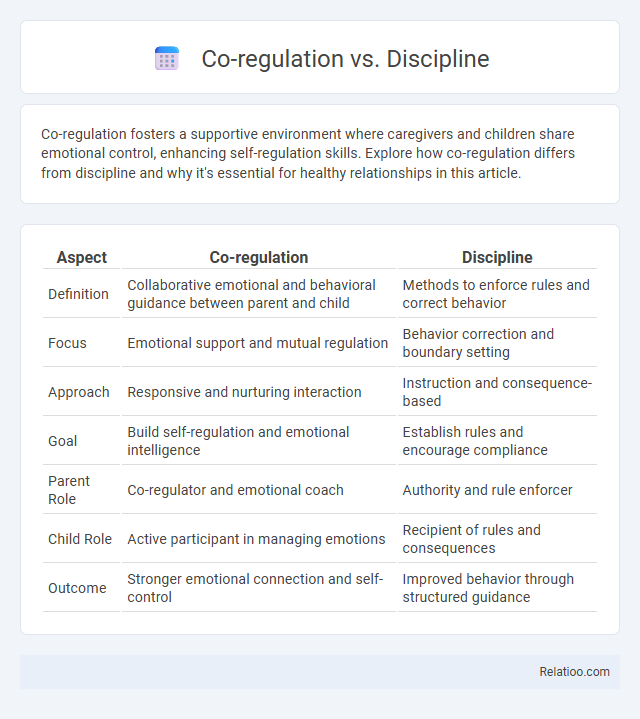Co-regulation fosters a supportive environment where caregivers and children share emotional control, enhancing self-regulation skills. Explore how co-regulation differs from discipline and why it's essential for healthy relationships in this article.
Table of Comparison
| Aspect | Co-regulation | Discipline |
|---|---|---|
| Definition | Collaborative emotional and behavioral guidance between parent and child | Methods to enforce rules and correct behavior |
| Focus | Emotional support and mutual regulation | Behavior correction and boundary setting |
| Approach | Responsive and nurturing interaction | Instruction and consequence-based |
| Goal | Build self-regulation and emotional intelligence | Establish rules and encourage compliance |
| Parent Role | Co-regulator and emotional coach | Authority and rule enforcer |
| Child Role | Active participant in managing emotions | Recipient of rules and consequences |
| Outcome | Stronger emotional connection and self-control | Improved behavior through structured guidance |
Understanding Co-regulation and Discipline
Co-regulation involves a dynamic process where caregivers support and guide a child's emotional and behavioral responses, promoting self-regulation through empathetic interaction and clear boundaries. Discipline, in contrast, typically emphasizes setting rules and consequences to shape behavior, often relying on external control rather than internalized self-regulation. Understanding co-regulation highlights its role in fostering emotional resilience and social competence, making it a foundational practice in healthy child development.
Key Differences Between Co-regulation and Discipline
Co-regulation emphasizes a collaborative process where You guide and support Your child's emotional and behavioral development through mutual trust and understanding, fostering self-regulation skills gradually. Discipline typically involves setting clear rules, consequences, and consistent enforcement to shape acceptable behavior and maintain order. The key differences between co-regulation and discipline lie in their approach: co-regulation prioritizes emotional connection and responsiveness, while discipline focuses on authority and behavioral correction.
The Role of Emotions in Co-regulation
Emotions play a crucial role in co-regulation by helping You and your child navigate stress and restore emotional balance through mutual responsiveness and support. Unlike traditional discipline, which often emphasizes control or consequences, co-regulation fosters emotional connection that promotes self-regulation skills over time. This interactive process strengthens emotional intelligence and resilience, making co-regulation a foundational aspect of effective behavioral guidance.
Traditional Discipline: Methods and Outcomes
Traditional discipline methods emphasize external control through rules, consequences, and punishment to shape behavior. These approaches often rely on hierarchical authority and may lead to compliance but can overlook emotional regulation and autonomy development. Outcomes typically include immediate behavior correction but risk fostering resentment, reduced intrinsic motivation, and limited social-emotional growth.
Benefits of Co-regulation in Child Development
Co-regulation in child development fosters emotional security by helping children understand and manage their feelings through supportive adult guidance, promoting healthy social and cognitive growth. Unlike traditional discipline, which often centers on behavior correction, co-regulation emphasizes connection and mutual regulation, enhancing your child's ability to self-regulate and navigate complex emotions independently. This approach leads to improved executive functioning, stronger parent-child relationships, and long-term resilience in your child's development.
Common Misconceptions About Discipline
Common misconceptions about discipline include confusing it solely with punishment, neglecting its role in teaching self-control and responsibility. Discipline involves guiding behavior through consistent, supportive strategies rather than harsh penalties. Effective discipline cultivates cooperation and emotional regulation, distinguishing it from coercive control or simple rule enforcement.
Integrating Co-regulation into Daily Routines
Integrating co-regulation into daily routines strengthens emotional connection and supports your child's self-regulation by providing consistent, responsive guidance. Unlike traditional discipline, which often focuses on consequences and behavior correction, co-regulation emphasizes mutual support and understanding during challenging moments. By embedding co-regulation strategies into everyday interactions, you foster resilience and emotional intelligence, reducing the need for punitive measures.
Long-term Effects: Co-regulation vs Discipline
Co-regulation promotes secure attachment and emotional intelligence, fostering long-term positive social and mental health outcomes in children, unlike traditional discipline, which may lead to anxiety or compliance without understanding. Your approach to co-regulation supports self-regulation skills by guiding children through emotional experiences rather than imposing external control, resulting in better resilience and decision-making abilities. Research shows children raised with co-regulation strategies exhibit higher empathy and adaptive coping mechanisms compared to those subjected primarily to disciplinary methods.
Practical Strategies for Parents and Educators
Effective co-regulation involves parents and educators guiding children's emotional responses through calm modeling and empathetic communication, fostering self-awareness and self-control. Discipline emphasizes setting clear boundaries and consistent consequences to shape behavior, while co-regulation centers on collaborative support to manage emotions and develop regulation skills. Your practical strategy should combine firm, consistent rules with empathetic responses, using techniques like deep breathing, reflective listening, and positive reinforcement to promote both behavioral compliance and emotional growth.
Choosing the Right Approach for Healthy Relationships
Choosing the right approach for healthy relationships involves understanding the nuances between co-regulation, discipline, and self-regulation. Co-regulation emphasizes mutual support and emotional attunement, fostering trust and connection, whereas discipline focuses on setting boundaries and consequences to guide behavior. Your ability to balance these strategies promotes emotional growth and strengthens relational bonds, ensuring both respect and empathy thrive.

Infographic: Co-regulation vs Discipline
 relatioo.com
relatioo.com